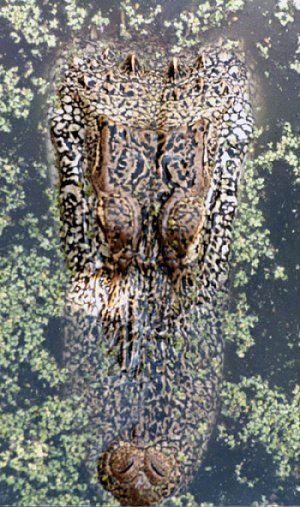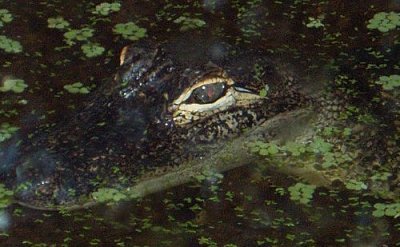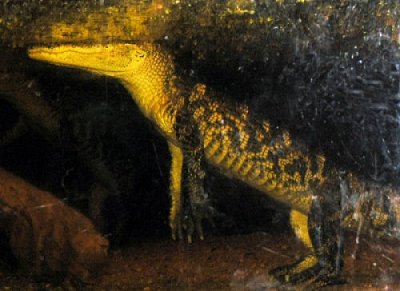Crocodile/Alligator
Today, the sensitive crocodile. The University of Houston's college of engineering presents this series about the machines that make our civilization run, and the people whose ingenuity created them.
The family of crocodiles has four varieties: alligators, crocodiles, tomistomas, and gavials. Actually, you find as much variation within those subspecies as you do among them. One must look closely to tell a crocodile from an alligator or a gavial. Since crocodiles and alligators are both found in Florida, Floridians are told to look at the lower jaw when the mouth is closed. If any lower teeth show, it's probably a crocodile.
Now science writer Natalie Angier writes about these beasts. Under her title, Not Just Another Pretty Face, is a picture that's guaranteed to give small children bad dreams. Just below the water's surface, we see a half open mouth with jagged rows of vicious teeth. Just above, an obsidian eye assesses your value as supper.
Like sharks or cockroaches, the various crocodiles are ancient survivors. They are close kin to the dinosaurs, with whom they coexisted two hundred million years ago. Like sharks or cockroaches, they survive because they are so highly evolved.
 The latest in a long line of discoveries about crocodiles is they have nodules located at various spots on their bodies. These nodules are equipped with very sensitive receptors. They can sense tiny movements in the water around them as they quietly patrol, on watch for prey or predators alike. Sometimes their eyes are above the surface; sometimes they're submerged.
The latest in a long line of discoveries about crocodiles is they have nodules located at various spots on their bodies. These nodules are equipped with very sensitive receptors. They can sense tiny movements in the water around them as they quietly patrol, on watch for prey or predators alike. Sometimes their eyes are above the surface; sometimes they're submerged.
Crocodiles turn out to be surprisingly smart. They're adept at telling friendly humans from hunters. They use a large range of vocalizations to communicate with one another. They nurture their young for years, they live almost as long as we do, and (as one crocodile zoologist put it) they are as curious as kittens.
Of course their faces frighten us, and we respond by killing them. In Florida, where one is hard pressed to tell alligators and crocodiles apart, the crocodile is the endangered one. Consequently, to protect one we have to protect both.
Alligators are almost extinct in China. Therefore, the government appeals to national pride: Alligators are the prototype of the Chinese dragon and must, therefore, be allowed to survive.
Finally, one cannot speak of crocodiles without mentioning their tears. In fact, they don't weep; but, in 1607, British naturalist Edward Topsell wrote this about them:
There are not many brute beasts that can weep, but such is the nature of the crocodile that, to get a man within his danger, he will sob, sigh, and weep as though he were in extremity, but suddenly he destroyeth him.
That image moved both Shakespeare and Spenser to write about the hypocrite who weeps crocodile tears. And that is how we still view the crocodile. Meanwhile, this quiet beast lives in cautious reserve, staying out of unnecessary trouble. And, every now and then, he feasts upon a fish or a deer, or (without any trace of hypocrisy) on one of us.
I'm John Lienhard, at the University of Houston, where we're interested in the way inventive minds work.
S. Grenard, Handbook of Alligators and Crocodiles. (Illustrated by W. Loutsenhizer) Malabar, FL: Krieger Publishing Co., 1991.
N. Angier, Not Just Another Pretty Face. The New York Times, Science Times, Tuesday, October 26, 2004, pg D1 and pg. D4.
W. T. Neill, The Last of the Ruling Reptiles: Alligators, Crocodiles, and their Kin. New York: Columbia University Press, 1971.
See also Encyclopaedia Britannica entries under crocodile and alligator.
Topsell, E., The History of Four-Footed Beasts and Serpents and Insects.New York: Da Capo Press, 1967. (This is a facsimile of the original edi-tion: London: Printed by William Iaggard, 1607.)
Photos by John and Carol Lienhard.

